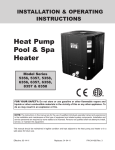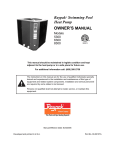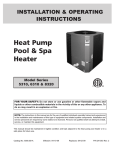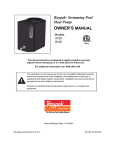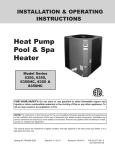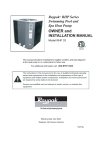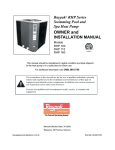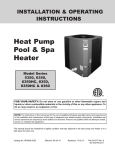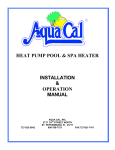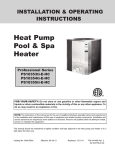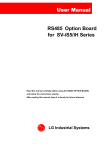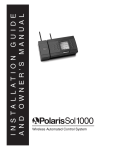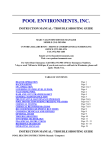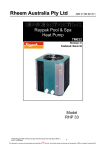Download Rheem Compact Heat Pump Pool Heaters Installation and Operation Manual
Transcript
INSTALLATION & OPERATING INSTRUCTIONS Heat Pump Pool & Spa Heater Model Series 2350, 3350, 4350, 4350PD R C LI S TED US FOR YOUR SAFETY: Do not store or use gasoline or other flammable vapors and liquids or other combustible materials in the vicinity of this or any other appliance. To do so may result in an explosion or fire. NOTE: The instructions in this manual are for the use of qualified individuals specially trained and experienced in the installation and maintenance of this type of equipment and related system components. Installation and service personnel are required by some states to be licensed. Persons not qualified shall not attempt to install, service, or maintain this equipment. This manual should be maintained in legible condition and kept adjacent to the heat pump pool heater or in a safe place for future use. Catalog No. 6000.553C Effective: 06-28-13 Replaces: 11-01-11 P/N 241429 Rev. 4 92-103778-02-05 Water Chemistry (Corrosive water voids all warranties) For your health and the protection of your pool equipment, it is essential that your water be chemically balanced. The following levels must be used as a guide for balanced water. Recommended Level(s) Water Temp. (Deg. F) pH Total Alkalinity (PPM) Calcium Hardness (PPM) Salt (PPM) Free Chlorine (PPM)* Total Dissolved Solids (PPM) Fiberglass Pools Fiberglass Spas Other Pool & Spa Types 7.3 to 7.4 7.3 to 7.4 7.6 to 7.8 68 to 88 89 to 104 68 to 104 120 to 150 120 to 150 150 to 200 200 to 400 4500 MAXIMUM 4500 MAXIMUM 4500 MAXIMUM 3000 MAXIMUM** 3000 MAXIMUM** 3000 MAXIMUM** 200 to 300 2 to 3 2 to 3 80 to 120 2 to 3 *Free Chlorine MUST NOT EXCEED 5 PPM! ** In salt water chlorinated pools, the total TDS can be as high as 6000ppm. • • • Occasional chemical shock dosing of the pool or spa water should not damage the heater providing the water is balanced. Automatic chemical dosing devices and salt chlorinators are usually more efficient in heated water. Unless controlled, they can lead to excessive chlorine level which can damage your heater. Further advice should be obtained from your pool or spa builder, accredited pool shop, or chemical supplier for the correct levels for your water. Rev. 4 reflects the following: Changes to: Picture on page 1, Installation Considerations on page 5, Fig. 2 on page 7, Table B on page 13, wiring diagram on page 18 Additions: “4350PD” model on page 1. Deletions: None. 2 CONTENTS Water Chemistry Warnings Pay Attention to These Terms Introduction Installation Considerations Electrical Connections Water Connections Controls Controls Operating Instructions To Select Pool or Spa Mode To Increase the Desired Water Temperature (Pool or Spa Mode) To Lower Desired Water Temperature (Pool or Spa Mode) To Select Temperature in °C or °F System Start-Up Seasonal Start-Up or Annual Check Summer Shutdown 2 4 4 5 5 6 8 9 9 9 Freeze Protection System Drain-Down Continuous Pump Operation Maintenance Air Coil Cleaning Cabinet Care (optional) Unplug Condensation Drain Holes Troubleshooting Service Call Verification Power Supply Water Flow Time Clock Adjustment Installing a Remote Control Device Wiring Heater Settings Plumbing Diagrams Wiring Diagram — 208V/230V Single-Phase 9 9 9 10 10 10 3 10 10 10 11 11 11 11 11 12 12 12 12 12 12 13 14 18 Warnings DANGER: WARNING: CAUTION: NOTE: — Pay Attention to These Terms Indicates the presence of immediate hazards which will cause severe personal injury, death or substantial property damage if ignored. Indicates the presence of hazards or unsafe practices which could cause severe personal injury, death or substantial property damage if ignored. Indicates the presence of hazards or unsafe practices which could cause minor personal injury or product or property damage if ignored. Indicates special instructions on installation, operation, or maintenance which are important but not related to personal injury hazards. This manual, as well as the pool/spa heat pump pool heater itself, contains ANSI-approved product safety signs and labels. Please read these signs and labels, as they convey important safety information about hazards that may be potentially present in and around the heat pump pool heater. CAUTION: Elevated water temperature can be hazardous. The U.S. Consumer Product Safety Commission has these guidelines: CAUTION: Improper chemical content in a swimming pool or spa can damage the heat pump pool heater. DO NOT add pool chemicals to the skimmer. This will damage the heat pump pool heater and could void the heat pump pool heater warranty. ALWAYS follow the product manufacturer’s directions when adding any chemicals to your pool. 2. Drinking of alcoholic beverages before or during spa or hot tub use can cause drowsiness which could lead to unconsciousness and subsequently result in drowning. WARNING: These heat pump pool heaters are charged with R-410A refrigerant. Ensure that all service work is done with gauges and equipment suitable for R-410A. 1. Spa water temperatures should never exceed 104°F (40°C). A temperature of 100°F (38°C) is considered safe for a healthy adult. Special caution is suggested for young children. 3. Pregnant Women Beware! Soaking in water over 102°F (39°C) can cause fetal damage during the first three months of pregnancy resulting in the birth of a brain-damaged or deformed child. Pregnant women should stick to the 100°F (38°C) maximum rule. 4. Before entering the spa or hot tub, users should check the water temperature with an accurate thermometer; spa or hot tub thermostats may err in regulating water temperatures by as much as 4°F (2.2°C). 5. Persons with a medical history of heart disease, circulatory problems, diabetes, or blood pressure problems should obtain a physician's advice before using pools or hot tubs. 6. Persons taking medications which induce drowsiness, such as tranquilizers, antihistamines, or anticoagulants, should not use spas or hot tubs. 4 Introduction CAUTION: The unit’s supporting base must be high enough to keep it completely free of standing water at all times. WARNING: This pool/spa heat pump pool heater is an electromechanical machine that incorporates a pressurized refrigerant gas in a sealed system. ONLY trained and qualified service personnel are authorized to install or service this equipment. Without proper training and knowledge of such equipment, any attempt to install or service the unit could result in serious injury or even death. Situate the heat pump pool heater carefully to minimize installation costs while providing maximum efficiency of operation, and to allow adequate service access, as follows: • This manual contains important information on the use, maintenance and troubleshooting of your new heat pump pool heater. This unit must be properly installed, maintained and operated for optimal performance. • This heat pump pool heater is an extremely efficient, economical machine designed specifically for swimming pool heating. It is similar in design and operation to a typical residential air conditioning system. The unit employs a hermetic motor/compressor operating in a refrigeration cycle to extract heat from ambient air and deliver it to the circulating pool water. • As with all heat pump pool heaters, compared to other types of heaters such as gas or oil-fired, this heat pump pool heater has lower heating capacity on a BTUH/hr basis. As a result, it will be required to operate longer to accomplish the desired results. It may, at certain times, operate as much as 24 hours per day. However, this should not be of concern to the owner, because the unit is designed to operate continuously. Even though it may operate continuously for many hours, it will still heat the pool with greater economy than other types of fossil fuel heaters. • • • Place a cover or blanket over the pool at night and other non-use periods. This will keep evaporation, the cause of main heat loss, to a minimum, and will greatly reduce pool heating costs. During warmer weather, the cover may be required only at night. • Installation Considerations • WARNING: Do not install the unit within 3 ft of fossil fuel burning heaters. Air intake along the sides of this heat pump pool heater could disturb the combustion process of the unit, and could cause damage or personal injury. • Mount the unit on a level, sturdy base, preferably a concrete slab or blocks. The size of the base should be at least 3 ft by 3 ft. • 5 For unrestricted air intake and service access, position each side of the unit at least 1 ft (30 cm) from walls, pipes and other obstructions. WARNING: This unit is designed for outdoor installation; DO NOT install it in an enclosed area such as a shed or garage. Recirculation of cold discharge air back into the evaporator coil will greatly reduce the unit’s heating capacity and efficiency. This unit features an ‘up-flow’ discharge for quiet operation. Air is pulled up through the evaporator coil and discharged through the top grill. Allow at least 5 ft (1.5 m) clearance above the unit for unrestricted air discharge. DO NOT install the unit under a porch or deck. Refer to Fig. 1. To minimize water piping, locate the unit as close as possible to the existing pool pump and filter. If the location of the heat pump pool heater is below the water line of the pool, the water pressure switch might need to be adjusted or an external water flow switch might be needed. Irrigation water should be directed away from the heat pump pool heater-water spray can damage the heat pump pool heater. Rain water run offs- the heat pump pool heater can withstand normal rain. Install rain gutters to prevent direct steams of rain water to the heat pump pool heater. It is important to keep the area next to the heat pump pool heater clear of shrubs, bushes and chemicals containers. They could prevent air from circulating fully through the heat pump pool heater, and will affect the operation of the heat pump pool heater or damage the heat pump pool heater. When installed in areas where freezing temperatures can be encountered, drain the water circuit to prevent possible freeze-up damage. See the Freeze Protection Section. 60” (1.52m) MIN 3 ft. (0.9m) MIN Electrical Connections 12” (0.3m) MIN Fig. 1: Installation Clearances • Refer to the unit rating plate for precise power requirements for your unit, and for ampacity and over-current protection requirements. • All wiring must be in accordance with the National Electrical Code, NFPA No. 70, latest edition, and all applicable state and local codes. The wiring diagram is located on page 18. • Remove the electrical access panel and route electrical supply wiring through the hole in the bottom of the junction box. Use an approved conduit connector or strain relief in compliance with NFPA 70. VAC in - Phase - Hz 2350 208/230 - 1 - 60 4350 208/230 - 1 - 60 3350 In sizing power wiring, be especially aware of upsizing requirements necessary due to wiring distances. Always satisfy applicable codes and standards. Electrical installation should be done by a licensed electrician only. This unit is pre-wired to work with external control systems, heat-on-demand options and other external time clock overrides. Refer to the external control system’s instructions, and page 12 of this manual, for installation information. NOTE: Refer to the National Electrical Code, Article 680, for general requirements for swimming pools and equipment, and to Article 440 for special considerations necessary for circuits supplying hermetic refrigeration motor/compressors. Model No. Locate the equipment disconnect means within 3 feet (0.9m) of the heater’s electrical enclosure, or as close to the heater as possible. Always satisfy applicable codes and standards. Minimum Circuit Ampacity (A) Maximum Breaker Size (A) 30 50 23 208/230 - 1 - 60 34 Table A: Typical System Electrical Power Requirements 6 35 50 Fig. 2: Hurricane Tie Down Specifications 7 COVERED UNIT HEIGHT 27-1/2” HIGH WIND LOAD RESTRAINT DETAIL 1 2-1/2” MIN. SPACING TYP. MIN. PAD LENGTH 38” MIN. PAD LENGTH 34” 3350 COVERED UNIT HEIGHT 24-3/8” 2350 MIN. PAD LENGTH 38” (1) 1/4” CONCRETE SCREW LENGTH TO PENETRATE 2-3/8” MINIMUM. CONCRETE PAD (SEE PAD SPECS.) MINIMUM 18 GA. X 1-1/2” WIDE GALV. STEEL STRAP (G90) OR EQUIVALENT (MIN. QTY. OF 4 STRAPS) WITH (2) 1/2” LONG #12 SELF DRILLING SCREWS EACH STRAP (MIN. 1000 HR. COATING) THE TIE DOWN STRAPS MUST BE INSTALLED IN OUTER MOST LOUVERS AS SHOWN. INSTALL TIE DOWN STRAPS ON OPPOSITE SIDE OF UNIT ALSO. HIGH WIND LOAD RESTRAINT DETAIL 2 CONCRETE PAD (SEE PAD SPECS.) UNIT MIN. PAD WIDTH 38” 4350 COVERED UNIT HEIGHT 35-3/8” SEE HIGH WIND LOAD RESTRAINT DETAIL 1 & 2 THE TIE DOWN STRAPS MUST BE INSTALLED IN OUTER MOST LOUVERS AS SHOWN. INSTALL TIE DOWN STRAPS ON OPPOSITE SIDE OF UNIT ALSO. MIN. PAD WIDTH 34” SEE HIGH WIND LOAD RESTRAINT DETAIL 1 & 2 UNIT HIGH WIND LOAD RESTRAINT DETAIL 3 THIS DETAIL IS SPECIFIC TO 35-3/8” TALL UNITS MIN 4” BETWEEN CONCRETE SCREWS MINIMUM 18 GA. X 1-1/2” WIDE GALV. STEEL STRAP (G90) OR EQUIVALENT (MIN. QTY. OF 8 STRAPS) WITH (2) 1/2” LONG #12 SELF DRILLING SCREWS EACH STRAP (MIN. 1000 HR. COATING) THE TIE DOWN STRAPS MUST BE INSTALLED IN OUTER MOST LOUVERS AS SHOWN. INSTALL TIE DOWN STRAPS ON OPPOSITE SIDE OF UNIT ALSO. MIN. PAD WIDTH 38” SEE HIGH WIND LOAD RESTRAINT DETAIL 1, 2 & 3 186 MPH, 3 SEC. GUST IN ACCORDANCE WITH: ASCE 7-2010 CHAPTER 30 WIND LOADS - COMPONENTS AND CLADDING FLORIDA BUILDING CODE 2010 - SECTION 1609 WIND LOADS FLORIDA BUILDING CODE 2010 - SECTION 1620 HIGH VELOCITY HURRICANE ZONES - WIND LOADS PAD SPECIFICATION: GREATER THAN OR EQUAL TO 4” THICK SOLID CONCRETE 3000 P. S. I. OR GREATER LOAD RATING PAD LENGTH GREATER THAN OR EQUAL TO UNIT LENGTH +6” PAD WIDTH GREATER THAN OR EQUAL TO UNIT WIDTH +6” THIS DRAWING USED AS A GRAPHICAL REPRESENTATION ONLY AND IT MAY NOT APPEAR EXACTLY LIKE YOUR SPECIFIC UNIT. Water Connections 4. In cold weather (freeze zone) areas, shutoff valves (ball or gate type) must be installed at the unit inlet and outlet to facilitate service and cold weather drain-down. CAUTION: The heat pump pool heater inlet and outlet connections are NOT interchangeable. They must be connected as instructed below. 5. Operate the pump and check the system for leaks. 1. Connect the heat pump pool heater in the return water line between the filter and the pool/spa. See the Plumbing Diagrams beginning on page 14. 2. Connect the filter outlet to the fitting marked WATER IN at the bottom front of the unit. NOTE: Refer to the National Electrical Code, Article 680, for general requirements for swimming pools and equipment, and to Article 440 for special considerations necessary for circuits supplying hermetic refrigeration motor/compressors. Water connections from the unit to the main return line can be PVC pipe or flexible pipe approved for the purpose and, in either case, should be at least equal in size to the main pool/spa circulation piping. WARNING: Install a check valve and/or a Hartford loop AFTER the heat pump pool heater and BEFORE any chlorinating devices. Install any automatic chemical feeders AFTER the heat pump pool heater. Improper installation of any type of automatic chemical feeders can result in serious damage to, or premature failure of, the heat pump pool heater and will void the heat pump pool heater warranty. 3. Connect the fitting marked WATER OUT to the return piping to the pool/spa. Unit inlet/outlet connection fittings are 1-1/2 inch PVC unions. Fig. 3: Utility Connections CAUTION: Caps must be reinstalled after service is complete. NOTE: Units are provided with 1/4” service ports, as shown in Fig. 3 above. The upper port is for measuring high pressure, and the lower port is for measuring the low pressure. 8 Controls Operating Instructions Controls Your heat pump pool heater incorporates digital safety controls and indicators to ensure its safe, reliable operation. The electronic board has the capability of memorizing two different programmed temperature settings as follows (refer to Fig. 4): Water Pressure Switch: Prevents operation when the pump is OFF. The unit requires 5 psi minimum pressure. • • Digital Water Temperature Control: The pool water temperature is controlled by the heat pump pool heater’s digital control system, which gives you the option of two settings: one for the desired spa temperature and the other for the desired pool temperature. Additionally, as mentioned earlier, the unit is compatible with most ‘2-wire’ and ‘3-wire’ control/automation systems. For a pool, maximum 95°F (35°C) For a spa, maximum 104°F (40°C) To Select Pool or Spa Mode To have access to either one of these programs, press the SET key until you see P _S and by pressing the UP or DOWN key you can switch to POL or SPA. To Increase the Desired Water Temperature (Pool or Spa Mode) Defrost Sensor: Prevents unit operation if ambient air temperature falls below a predetermined safe minimum (approximately 42°–48°F (5.5°–8.8°C), based on humidity). The compressor will shut OFF but the fan will continue to run. Push the SET key until you see POL or SPA. The programmed temperature will be displayed. Press the UP arrow to increase the temperature setting one degree at a time. Delay Timer: Prevents compressor from short cycling, which could damage or destroy the hermetic motor/compressor. Upon water temperature control satisfaction, or other circuit interruptions, this solid state device will prevent compressor restart for approximately 5 minutes. To Lower the Desired Water Temperature (Pool or Spa Mode) Push the SET key until you see POL or SPA. The programmed temperature will be displayed. Press the DOWN arrow to decrease the temperature setting one degree at a time. Once the control has been programmed to the desired pool water temperature, the programmed temperature will be displayed for approximately 5 seconds. Then the digital display will display the actual pool water temperature. To make the Board a Pool ONLY Board, call 800260-2758 for instructions. To Select Temperature in °C or °F Press the SET key until you see F _C. By pressing the UP or DOWN key you can switch to °F or °C. Once the temperature display mode has been programmed it will be displayed for approximately 5 seconds, then the digital display will return to the actual pool water temperature in the mode that you have chosen. Fig. 4: Digital Water Temperature Control 9 Summer Shutdown System Start-Up If you do not plan to use the heat pump pool heater during the summer months, secure and protect it as follows: 1. Verify that the Digital Board is displaying a temperature and the pool pump is running and water is circulating properly. 1. Turn the unit circuit breaker or disconnect switch to OFF. 2. Verify that the Board is programmed so that the desired temperature of the Pool and Spa is higher than the displayed current water temperature. 2. Leave the valves set the way they are unless additional circulation is required. DO NOT stop all flow through the heat pump pool heater. 3. Allow the heat pump pool heater to operate for a few minutes to stabilize operating pressures and to allow various component temperatures to normalize. 3. IMPORTANT: Remember to reset the valves before the next heating season, or the unit will not operate properly. 4. Verify that the discharge air temperature is approximately 4°–5°F (2.2°–2.8°C) cooler than the air entering the unit. If not, see the Troubleshooting Section. Freeze Protection If the unit is installed in a location subject to freezing conditions, it is important to protect the water circuit from freezing, just as should be done for the pump and filter. Seasonal Start-Up or Annual Check NOTE: At the beginning of the heating season, or whenever the pool water temperature is to be raised several degrees, the pool pump and heat pump pool heater may need to operate continuously for several days. During summer months, only a few hours per day may be necessary, or none at all. System Drain-Down 1. Turn the unit circuit breaker or disconnect switch to OFF. 2. With the pool pump OFF, close the external shutoff valves and loosen the inlet and outlet water unions to allow water to drain. Use a Wet/Dry Vac or air pressure to remove excess water. 1. Remove leaves, pine needles, etc., from the evaporator coil. Clean the coil by gently applying a mild solution of household liquid soap and water. 3. Loosely re-attach the unions. 2. Gently rinse the coil with water; DO NOT use high pressure. 4. Cover the unit with a waterproof cover. 3. Backwash or otherwise clean the pool filter. If necessary, clean the skimmer basket and pump strainer. Continuous Pump Operation It is also possible in some areas to prevent unit freeze damage by operating the pump continuously during freezing weather. However, this results in significantly higher pump operating costs. Further, if a sustained power failure occurs, the unit MUST be drained anyway, or freeze damage could result. NOTE: If the pool pump and heat pump pool heater shut OFF before the water temperature is raised to the desired level, you must lengthen the running time of both. To do this, reset the time clock dial for the longer running time, or manually operate the pump with the timer override switch. Since the heat pump pool heater capacity and efficiency are both greater at higher ambient air temperatures, run time should be set to take advantage of all daylight hours, when the air is generally warmer. 4. Set the valves to ensure proper water flow through the unit. 10 Maintenance Troubleshooting If your unit does not operate, or simply does not heat your pool water, Fault Codes on the front control panel, can provide valuable clues as to what is wrong, and may even indicate precisely what the problem is. Always observe these codes before calling a service representative. By reporting on the telephone the Fault Codes that are showing, the service rep may be able to solve the problem without the expense of a service call. NOTE: The heat pump pool heater MANUFACTURER IS NOT RESPONSIBLE for maintenance adjustments. The following maintenance procedures are designed to keep your unit operating at a high level of reliability. Maintenance must be performed on a periodic basis to maintain warranty coverage and prevent system failures and performance degradation. A. UNIT IS RUNNING, BUT NOT HEATING Air Coil Cleaning • Efficient operation depends on free circulation of air through the thin and tightly-spaced fins of the evaporator coil(s). The evaporator must be cleaned whenever it has a buildup of dirt or debris. • CAUTION: To clean the fins, spray gently with a garden hose. DO NOT pressure wash. Doing so will bend the fins and can void the warranty. • Cabinet Care (optional) The cabinet is designed for outdoor use and requires little care. However, you can clean it if you wish. • WARNING: Shut OFF electricity to the unit before cleaning. Is water flow through the unit adequate? Check the unit for obstructions, such as a clogged filter pump strainer, a dirty filter, or valves not positioned correctly. Is the ejected air from the unit 4°–5°F (2.2°–2.8°C) cooler than incoming air? If so, the unit is extracting heat from the air and transferring it to the pool. Is water condensing on the evaporator and internal copper pipes? This is also evidence of heat removal from the air. When the air is cool with low humidity, condensation may not be evident. How long has the unit been operating? During initial pool heating in cold weather, it may require a week to elevate the water temperature to a comfortable level. Normally, it takes about 4 days. How many hours per day is the unit operating? Remember that the heat pump pool heater only operates while the pool pump is running. Set the time clock to permit 24 hour per day operation. After the desired temperature is reached, return the unit to normal operation of 8–10 hours per day. Wash the cabinet with soap and water. Unplug Condensation Drain Holes The unit extracts humidity from the air as it passes through the coil, similar to the way a cold drink outside “sweats” on a hot day. This condensation drains from the bottom of the unit. NOTE: If the pool pump and heat pump pool heater shut OFF before the water temperature is raised to the desired level, you must lengthen the running time of both. To do this, reset the time clock dial for the longer running time, or manually operate the pump with the timer override switch. Since the unit capacity and efficiency are both greater at higher ambient air temperatures, run time should be set to take advantage of all daylight hours, when the air is generally warmer. 1. Routinely check to be sure the condensation drain holes in the base of the unit are not plugged with dirt or debris. 2. If condensation becomes a problem, optional drain pans are available from your heat pump pool heater distributor or pool dealer. 11 • • • Service Call Verification Is airflow through the unit being obstructed? Restrictions such as shrubbery, tall grass, dirty coils, or any other obstruction to airflow will reduce performance. The Service number is 800-260-2758 in the United States. For units in Canada, call 800-268-6966. Is the pool blanket/cover being used? Unblanketed pools can lose up to 10°F (5.5°C) per night compared to 4°F (2.2°C) or fewer when a blanket is used. Without a blanket, the total heat gained during the day can be lost overnight. Before you make a service call, first determine if the problem is: • • Are rapid heat losses occurring in some other way, such as high wind, spillage, rainfall, flow through solar panels at night, or a high water table? • • • Unit operation (power supply, water flow, or time clock adjustment) NOTE: The MANUFACTURER IS NOT RESPONSIBLE for these adjustments. B. UNIT IS NOT RUNNING • Warranty Service Power Supply Is the temperature display ON? If not, the circuit breaker may be shut OFF or tripped. Reset the breaker by switching it OFF, and then back ON. Verify that the breaker is set and operating properly before calling for service. • • Is the thermostat setting and the Pool/Spa setting correct? Verify that the temperature has been properly set on the thermostat, and that it is higher than the current water temperature. Verify that all circuit breakers are reset and working properly. If the temperature display does not light, contact the installing dealer, since it may be a power problem requiring an electrician. Water Flow • Have you waited approximately 5 minutes for the time delay? After the unit has been running and then shut OFF for any reason, there is a delay before operation can begin again. • Is the Heat Light ON? If not, then the thermostat setting is not higher than the temperature of the water. Raise the thermostat setting. Verify that the pool filter is clean to provide good flow. Verify that valves are properly positioned to allow adequate water flow through the unit. Time Clock Adjustment Verify that the time clock is set to permit the unit to run long enough to heat properly. NOTE: The heat pump pool heater will not run when the Remote position is selected on the Pool/Spa selector switch and there is no remote control system attached. Installing a Remote Control Device C. CONDENSATION SEEMS EXCESSIVE Wiring Heat pump pool heaters can produce a large amount of condensation (water) during operation. If you suspect that the unit is leaking: For a 2-wire control, use the TOTAL and COMMON connections on the heat pump pool heater wiring block. a. Use a pool chemistry test kit to confirm there is no chlorine in the condensation. Or, For a 3-wire control, use the COMMON, SPA and POOL connections on the heat pump pool heater wiring block. b. Shut the unit OFF and leave the filter pump running to see if the water stops dripping. If the water stops dripping, the unit is not leaking. 12 Fault Code OFF LP & LP3 HP & HP6 FLo & FL3 FS -- Meaning of Code The desired programmed temperature point is lower than 60°F (15°C). Shortage of refrigerant gas in the unit or faulty low pressure control. The unit will show (LP3) after 3 LP faults and shuts down the unit and pool pump for protection. If this occurs, you should call for service. Low water flow in the unit or faulty high pressure control. Check water flow/backwash. The unit will show (HP6) after 6 HP faults. This will stop the unit for protection. Possible causes: • The filter is in backwash position. • The filter pump is stopped. • The filter is dirty. • Shortage of water to pool pump. • Water pressure switch must be adjusted or it is broken. • The unit is in the protection mode and will show (FL3), press any key to restart the unit. FL3 code will stop the unit and pool pump. Unit is in the defrosting cycle. (The fan works but the compressor is stopped.) Keypad is pressing down on both buttons. Replace keypad. Table B: Control Board Fault Codes Heater Settings 1. Make sure the heater is disabled on the remote control device. Then, push the SET key until POL is displayed. Push the DOWN arrow key until OFF is displayed. Wait until a temperature is displayed before beginning the next step. 2. Push the SET key until SPA is displayed, then push the UP arrow to 104°F (40°C). Wait until a temperature is displayed before beginning the next step. Fig. 8: 2-Wire Remote Connection 3. Push the SET key until P_S is displayed, then push the DOWN arrow until POL is displayed. Wait until a temperature is displayed before beginning the next step. 4. Finally, enable the heater on the remote control device. When there is a call for heat, the heater display will show SPA. When the heater is disabled, the display will show POL. Fig. 9: 3-Wire Remote Connection 13 Plumbing Diagrams Fig. 5: For systems with pumps of less than 1-1/2 HP (under 50 gpm), no external bypass is required. Connections are 1-1/2 inch unions. Plumb the heat pump pool heater AFTER the filter and BEFORE any chlorinators. 14 Fig. 6: For systems with pumps of 1-1/2 HP or greater (over 50 gpm), an external bypass is required. Adjust the bypass valve to divert a minimum of 15 gpm through the heat pump pool heater. Connections are 1-1/2 inch unions. Plumb the heat pump pool heater AFTER the filter and BEFORE any chlorinators. 15 Fig. 7: Pool Piping for Heat Pump Pool Heater and Gas Pool Heater 16 Fig. 8: Pool Piping for Heat Pump Pool Heaters, Multiple, Primary/Secondary 17 MINIMUM PIPE SIZES 2 UNITS 3-4 UNITS 5-6 UNITS BRANCH MAIN BRANCH MAIN BRANCH MAIN 15 GPM 1-1/2" 1-1/2" 15 GPM 1-1/2" 1-1/2" 15 GPM 1-1/2" 2" 30 1-1/2" 1-1/2" 30 1-1/2" 2-1/2" 30 1-1/2" 3" 45 1-1/2" 2" 45 1-1/2" 3" 45 1-1/2" 4" 60 1-1/2" 2-1/2" 60 1-1/2" 4" 60 1-1/2" 4" *Sizing based on10 ft/sec flow rates Wiring Diagram - 208V/230V Single-Phase 18 19 Raypak, Inc., 2151 Eastman Avenue, Oxnard, CA 93030 (805) 278-5300 Fax (805) 278-5468 Heat Pump Service 1-800-260-2758 Litho in U.S.A. 20




















